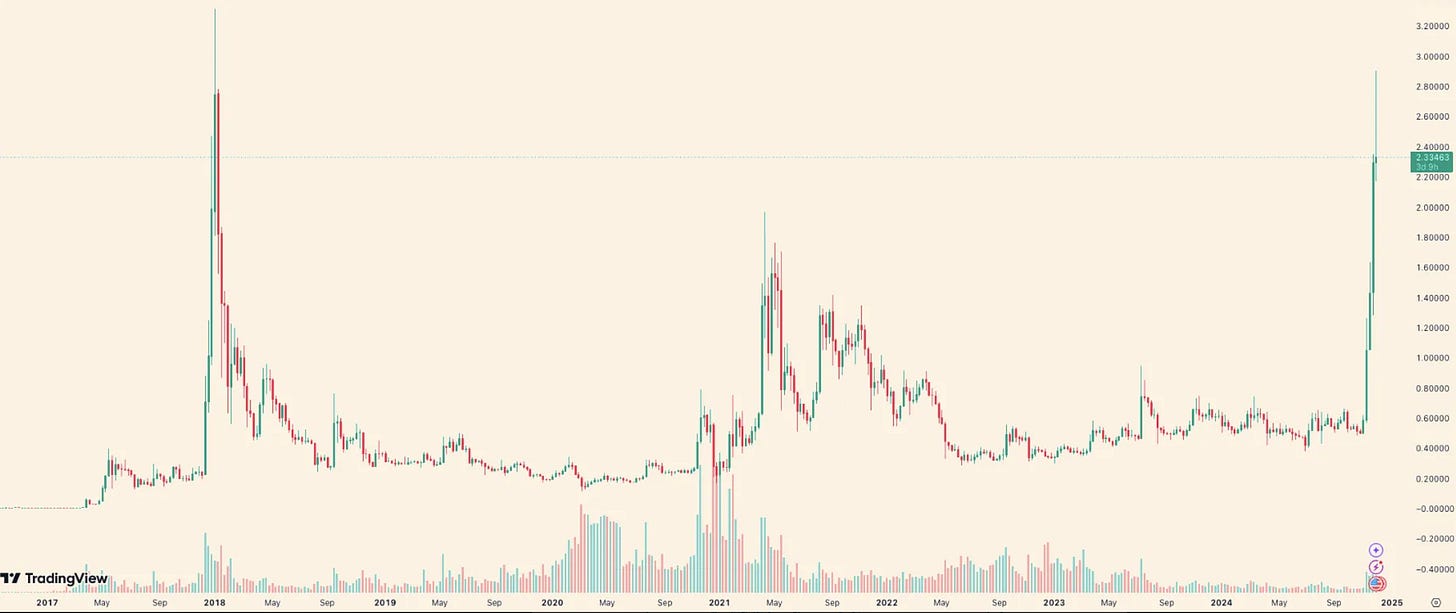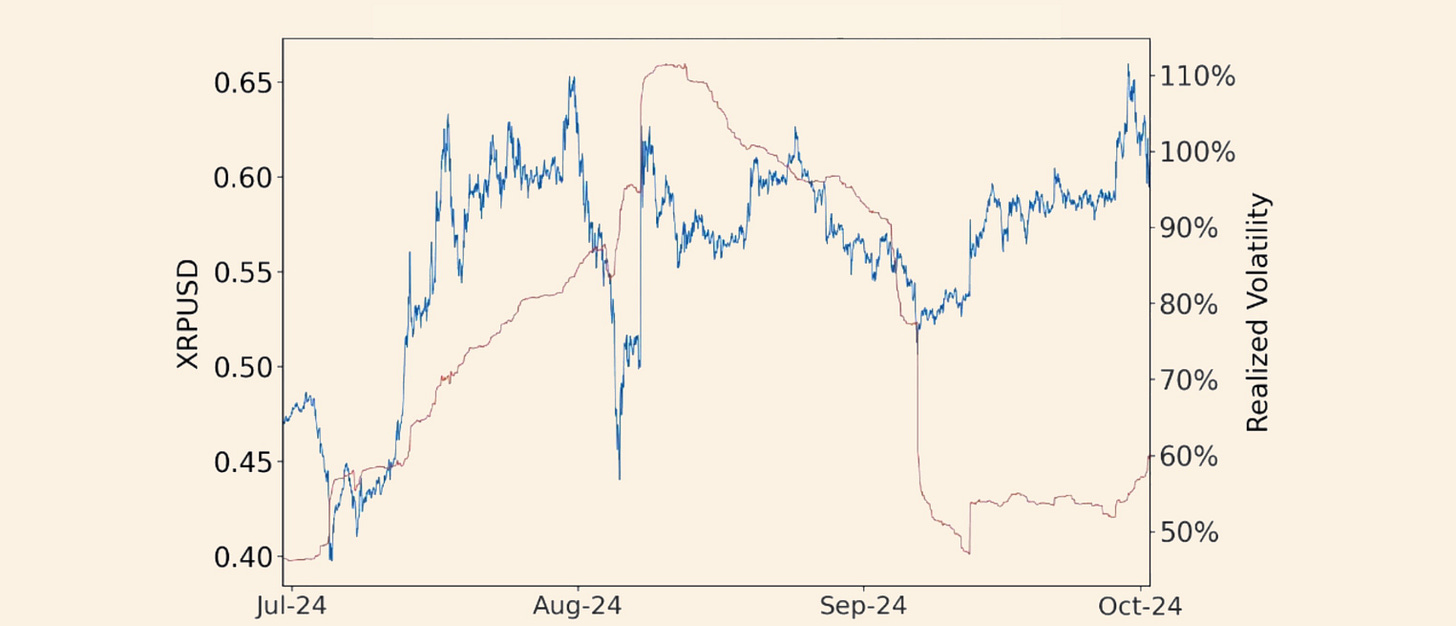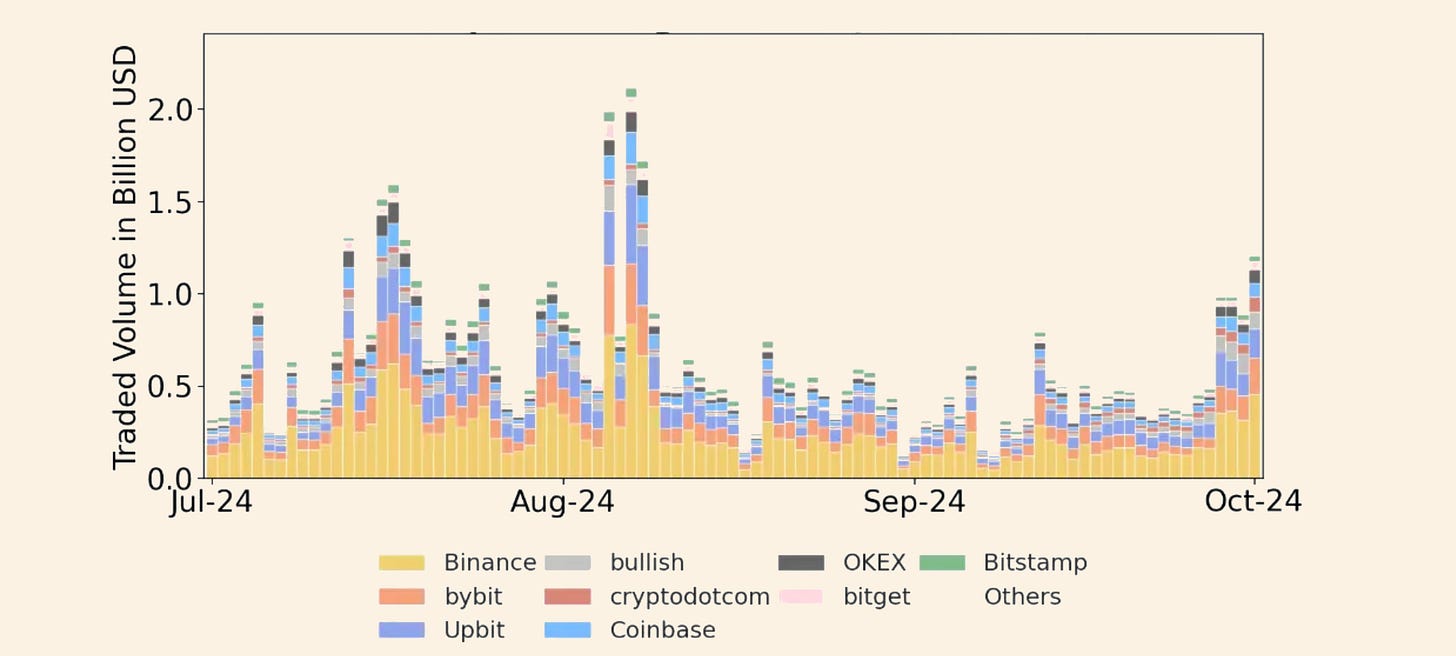What’s Behind XRP’s $50B Market Surge?
Over the past week, XRP's price has increased by approximately 60.96%, rising from $1.46 to $2.35, with its market capitalization surpassing $130 billion. This paper provides a concise overview of Ripple—the company behind XRP—its historical development, ecosystem, and latest advancements in real-world asset (RWA) tokenization and regulatory engagement. Ripple, founded as OpenCoin and rebranded as Ripple Labs in 2013, has established itself as a pioneer in blockchain technology, with a particular focus on cross-border payments and decentralized finance (DeFi). At the core of Ripple's ecosystem lies the XRP Ledger (XRPL), a high-performance distributed ledger developed in 2011 by David Schwartz, Jed McCaleb, and Arthur Britto. XRPL is designed to deliver efficient, scalable, and secure global payment solutions, aligning with Ripple’s vision of modernizing financial infrastructure. Recent developments highlight the growing utility of XRPL. On November 25, 2024, Ripple announced a groundbreaking collaboration with Archax, the first FCA-regulated digital asset exchange, to tokenize access to Abrdn’s £3.8 billion US Dollar Liquidity Fund (Lux) on the XRPL. This milestone marks the launch of the first tokenized money market fund on the ledger, further solidifying XRPL as a premier platform for RWA tokenization. In parallel, regulatory engagement has intensified. On December 2, 2024, WisdomTree joined Bitwise, 21Shares, and Canary Capital in filing for SEC approval to launch spot XRP ETFs, underscoring the asset’s increasing institutional appeal and the broader adoption of tokenized financial instruments.
State of XRP: Q3 2024
Ripple's quarterly XRP Markets Report highlighted key developments in XRP and the broader crypto market. XRP maintained its legal status as not a security, a landmark ruling that led to its relisting on U.S. exchanges and global platforms correctly distinguishing XRP from Ripple. Institutional interest surged, with Grayscale launching an XRP Trust and Bitwise, Canary, and 21Shares filing for XRP ETFs. This institutional momentum reflects growing confidence in XRP, which remains a top-10 asset by market capitalization. Crypto markets reacted to macroeconomic shifts, including a 50-basis-point rate cut by the U.S. Federal Reserve, driving risk asset rallies. The debut of U.S. ETH ETFs marked another milestone, with $552.2 million in inflows by quarter-end. Regulatory uncertainty persisted, however, with the SEC appealing aspects of its case against Ripple while conceding that XRP itself is not a security. Globally, jurisdictions like Japan, the UAE, and Hong Kong advanced crypto-friendly regulations, contrasting with U.S. enforcement actions and Operation Chokepoint 2.0 targeting crypto-related banks. Ripple secured regulatory approvals in Dubai and demonstrated its commitment to fostering crypto innovation through strategic investments and advocacy. As crypto ETFs lead market growth and the U.S. presidential election looms, regulatory clarity and industry maturation remain pivotal to the future of digital assets.
Core Team:
CEO: Brad Garlinghouse
Ripple Co-Founder & Executive Chairman: Chris Larsen
XRP Ledger CTO: David Schwartz
XRP Ledger Co-Founder: Arthur Britto
CFO: Jon Bilich
CLO: Stuart Alderoty
ex XRP Ledger & Ripple Co-Founder: Jed McCaleb (now Co-founder of Stellar)
Ripple Labs, Inc. (XRP) Funding Insights - Total Raised: $294.50M
Funding Rounds:
Undisclosed Round: Date: 11 Apr 2013 | Amount Raised: N/A
Investors: Andreessen Horowitz (a16z), Lightspeed Venture Partners, Vast Ventures
Seed Round: Date: 14 May 2013 | Amount Raised: N/A
Selected Investors: GV Google Ventures, IDG Capital
Seed Round: Date: 12 Nov 2013 | Amount Raised: $3.50M
Selected Investors: Core Innovation Capital, Camp One Ventures, IDG Capital, Hinge Capital
Series A Round: Date: 3 Dec 2014 | Amount Raised: $4.00M
Selected Investors: Santander
Series A Round: Date: 19 May 2015 | Amount Raised: $28.00M
Selected Investors: IDG Capital, Blockchain Capital, Digital Currency Group (DCG), Core Innovation Capital, RRE Ventures, CME Ventures
Extended Series A Round: Date: 6 Oct 2015 | Amount Raised: $4.00M
Selected Investors: Santander, CME Ventures, Seagate Technology
Series B Round: Date: 15 Sep 2016 | Amount Raised: $55.00M
Selected Investors: SBI Investment, Accenture, Santander, CME Ventures, Seagate Technology, Hinge Capital
Series C Round: Date: 20 Dec 2019 | Valuation: $9.8B | Amount Raised: $200.00M
Selected Investors: Tetragon Financial Group Limited, SBI Investment, Bossanova Investimentos, Route 66 Venture
Tokenomics
XRP, the native asset of the XRP Ledger, was created in 2012 with a fixed supply of 100 billion pre-mined tokens. Of this, 80 billion were allocated to Ripple Labs, while the remaining 20 billion were distributed among the founders. To stabilize the market and manage its holdings, Ripple placed 55 billion XRP into escrow accounts in 2017, with up to 1 billion XRP released monthly over 55 months. Unused XRP is returned to escrow, extending the release timeline. As of December 2024, Ripple holds approximately 37.24 billion XRP in escrow.
Ripple’s Stablecoin - RLUSD
RLUSD originally planned for launch on December 4, 2024, has experienced a delay. According to statements from Ripple, the company is actively collaborating with the New York Department of Financial Services (NYDFS) to obtain final regulatory approval. Ripple emphasized its dedication to adhering to stringent regulatory requirements and maintaining the highest operational standards.
First announced in April 2024, RLUSD will be fully backed by USD deposits, short-term U.S. government treasuries, and cash equivalents. Designed as an enterprise-grade, compliance-focused stablecoin, RLUSD is intended to complement Ripple’s cross-border payment solutions, operating alongside XRP. Given the stablecoin market’s projected growth to over $2.8 trillion by 2028, RLUSD is anticipated to contribute significantly to this expanding sector.
Key Metrics (December 5, 2024)
The XRP Ledger: A Detailed Overview
Unlike traditional Proof-of-Work (PoW) or Proof-of-Stake (PoS) blockchains, the XRP Ledger employs a Federated Consensus model. This mechanism allows validators to reach an agreement on the state of the ledger without relying on mining or staking. The consensus protocol is designed to be efficient, with low latency and minimal computational overhead, facilitating quick transaction finality.
Validator Network and Unique Node List (UNL)
The XRPL network comprises over 109 validators distributed globally. A subset of these validators forms the Unique Node List (UNL), which is crucial for achieving consensus. The UNL consists of 31 trusted validators, including entities such as Arrington XRP Capital, Bifrost Wallet, Ripple Labs, and XRPScan. While any entity can operate a validator and publish a UNL, the default UNL is heavily influenced by Ripple Labs and the XRP Ledger Foundation.
Centralization Concerns:
The reliance on a default UNL curated by influential organizations raises questions about centralization. Critics argue that the selection process for trusted validators is not entirely permissionless, potentially compromising the decentralized ethos of blockchain technology. However, proponents highlight that users have the autonomy to modify their UNL, allowing for a degree of decentralization based on individual trust preferences.
Consensus Process
The consensus process in XRPL operates through iterative rounds where validators propose and agree upon sets of transactions to include in the next ledger version. The process involves:
Proposal Phase: Validators submit proposed transaction sets.
Voting Phase: Validators adjust their proposals based on received proposals from their UNL peers.
Consensus Achievement: Once a supermajority (typically 80%) agreement is reached, the transaction set is applied to the ledger.
Ledger Validation: Validators publish signed validation messages containing the new ledger's hash, confirming consensus.
This mechanism ensures that all participants agree on the ledger's state and the order of transactions without the need for resource-intensive mining activities.
Transaction Speed, Fees, and Account Reserves
Transaction Speed
Transaction speed and capacity exhibit significant variation across blockchain platforms. XRP processes transactions within 3 to 5 seconds, supporting a throughput of approximately 1,500 transactions per second (TPS). Solana achieves sub-second transaction speeds and a maximum capacity of up to 65,000 TPS. In contrast, Bitcoin requires over 10 minutes per transaction and manages 5 to 6 TPS, while Ethereum processes transactions at a rate of 13 to 15 TPS.
Transaction Fees
The XRPL boasts minimal transaction fees, approximately 0.00001 XRP per transaction. This low cost makes it economically viable for users engaging in frequent transactions and micro-payments, aligning with the ledger's goal of facilitating efficient value transfer.
Trust Lines and Reserve Requirements
A distinctive aspect of the XRPL is the use of Trust Lines for token management. To activate a new XRPL account, users must reserve at least 10 XRP. Additionally, each unique token type held in the wallet requires an extra reserve of 2 XRP. These reserves serve as anti-spam measures, preventing ledger bloat and discouraging malicious activities.
Trust Lines Functionality:
Bilateral Agreements: Trust Lines act as bilateral credit agreements between two accounts, defining balance and trust parameters for each token.
Consent-Based Token Receipt: They ensure that no account can impose a token onto another without consent, maintaining user control over received assets.
Transaction Controls: Trust Lines enable features like freezing assets, requiring authorization for transfers, and setting the "No Ripple" flag to prevent unintended balance adjustments.
Rippling Mechanism
Rippling in the XRP Ledger (XRPL) facilitates efficient net settlements by adjusting token balances across interconnected Trust Lines, bypassing direct issuer involvement. Users retain control over this feature:
Enabled: Ideal for intermediaries like market makers to enhance liquidity.
Disabled: Recommended for users seeking protection from unintended balance adjustments.
This flexibility ensures tailored network participation based on user needs.
Hooks for Enhanced Functionality
Hooks, lightweight WebAssembly (WASM) code, enable programmable features such as transaction automation, compliance checks, or payment modifications. Deployed on the Xahau network—a sidechain to XRPL—Hooks enhance programmability while preserving mainnet stability.
EVM-Compatible Sidechain
The development of an Ethereum Virtual Machine (EVM)-compatible sidechain aims to:
Attract Ethereum developers and dApps.
Enable cross-chain asset transfers via bridging solutions like Axelar.
Currently in testing, the sidechain uses XRP as gas, positioning XRPL for broader blockchain interoperability.
Native AMM Integration
XRPL’s Automated Market Maker (AMM) enables decentralized token trading and liquidity provision directly on the ledger, supporting:
Liquidity pools for token pairs.
Decentralized finance (DeFi) participation without external dependencies.
This native AMM enhances XRPL's appeal within the DeFi ecosystem.
The XRP Ledger Consensus Protocol Detailed

Consensus mechanisms are the backbone of decentralized payment systems, ensuring all participants agree on the ledger's state without centralized control. The XRP Ledger Consensus Protocol emphasizes efficiency, security, and resilience against failure modes.
Key Features
Ledger Agreement: Ensures consensus on the latest state and transaction order.
Decentralization: Operates without a central authority, avoiding single points of failure.
Robustness: Advances even during participant changes or misbehavior.
Safety First: Prioritizes correctness, halting progress over validating incorrect transactions during disruptions.
Efficiency: Avoids energy-intensive processes typical of proof-of-work (PoW) systems.
Double-Spend Prevention
To prevent double-spending, the XRPL orders transactions deterministically. Only one of any conflicting transactions is validated, removing the need for centralized dispute resolution.
Ledger Structure
Each ledger version includes:
Current State: Account balances and objects.
Transaction Set: Transactions applied to the prior ledger.
Metadata: Details such as cryptographic hashes and ledger index.
This structure creates an immutable history, with each ledger containing the full current state for quick verification.
Trust-Based Validation
Participants form a Unique Node List (UNL), trusting validators to act non-maliciously. This trust model underpins the system's security: validators influence only those who trust them.
The consensus process involves:
Proposal: Validators submit transaction sets.
Voting: Validators adjust proposals based on peers' input.
Consensus: Supermajority agreement applies transactions.
Validation: Validators sign and publish the new ledger.
Fault Tolerance and Security
Validator Failures: Handles up to 20% faulty validators; halts if faults exceed 20% but remain under 80%, ensuring integrity.
Sybil Attack Resistance: Trust-based influence and manual UNL selection limit impact from fake identities.
Invariant Checking: Rejects transactions violating rules, such as unauthorized XRP creation.
Adaptive Fee Mechanism
Validators dynamically adjust transaction fees and reserve requirements, balancing accessibility and network protection. Key parameters include the base transaction fee, account reserves, and owner reserves, with decisions reached through median voting.
Enhancing Liveness: Negative UNL
To maintain progress during outages, Negative UNL temporarily excludes unavailable validators, adjusts quorum thresholds, and reintegrates them upon recovery. This feature ensures continuity without compromising security.
Ripple: Regulatory and Legal Developments
Ripple has encountered regulatory challenges throughout its operational history, reflecting the complexities of navigating the evolving legal landscape of blockchain and digital assets.
Key Milestones:
May 5, 2015: Ripple was fined $700,000 by the U.S. Treasury's Financial Crimes Enforcement Network (FinCEN) for violations of the Bank Secrecy Act, including operating as an unregistered money services business (MSB). Ripple agreed to implement compliance measures and enhance its protocol.
June 13, 2016: Ripple secured a BitLicense from the New York State Department of Financial Services, becoming the fourth company to receive this license.
September 2017: Blockchain firm R3 filed a lawsuit against Ripple, seeking enforcement of an agreement to purchase 5 billion XRP at $0.0085. Ripple countered with claims of opportunistic behavior by R3 as XRP's value surged. The dispute was resolved in September 2018 under undisclosed terms.
February 2020: The Financial Times reported that MoneyGram, a key Ripple partner, received $50 million from Ripple prior to adopting XRP-based liquidity tools. Ripple provided the tools free of charge and offered subsidies totaling $8.9 million in Q4 2019. XRP sales were highlighted as a primary driver of Ripple's profitability.
December 22, 2020: The SEC charged Ripple and its executives, Christian Larsen and Brad Garlinghouse, with raising $1.3 billion through unregistered securities offerings involving XRP. Ripple disputed the charges, and a court later restricted the SEC's access to extensive banking records of the defendants.
July 2023: In a landmark decision, a U.S. district court ruled that XRP, as sold in programmatic transactions on cryptocurrency exchanges, does not constitute a security under the Howey Test. However, institutional sales and fundraising involving XRP could qualify as securities. Judge Analisa Torres issued the ruling after two years of litigation.
October 2023: The SEC dropped lawsuits against Ripple executives Garlinghouse and Larsen, signaling a partial resolution to the case.
June 2024: Ripple revealed that its legal defense against the SEC had exceeded $100 million, underscoring the financial strain of prolonged regulatory scrutiny.
Conclusion
XRP’s recent $50 billion market cap surge reflects renewed market interest, yet skepticism remains around its long-term institutional adoption and regulatory challenges. Ripple’s advancements, including tokenized finance initiatives and ETF applications, signal progress but face hurdles, particularly in navigating complex legal and global frameworks. While the SEC ruling clarified XRP's status in some contexts, uncertainties persist, highlighting the need for cautious optimism about its role in the evolving financial ecosystem.
Sources
Risk Disclaimer:
insights4.vc and its newsletter provide research and information for educational purposes only and should not be taken as any form of professional advice. We do not advocate for any investment actions, including buying, selling, or holding digital assets.
The content reflects only the writer's views and not financial advice. Please conduct your own due diligence before engaging with cryptocurrencies, DeFi, NFTs, Web 3 or related technologies, as they carry high risks and values can fluctuate significantly.







